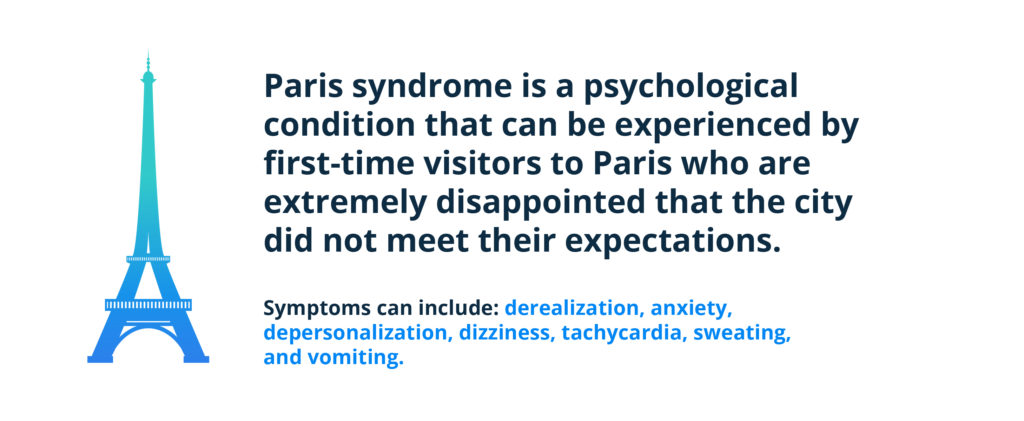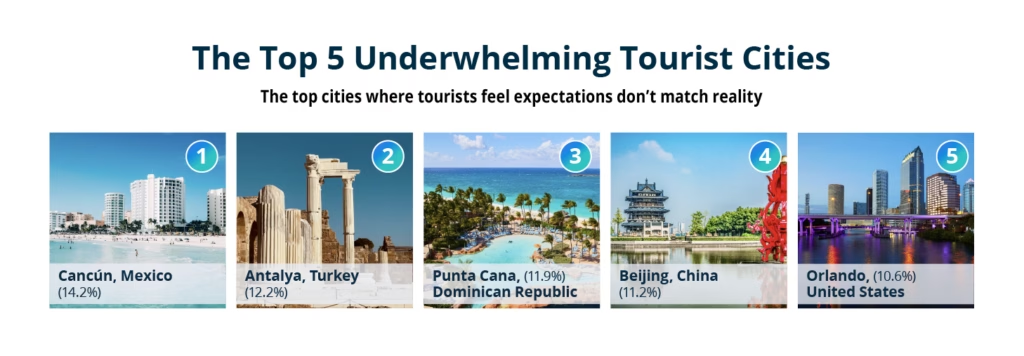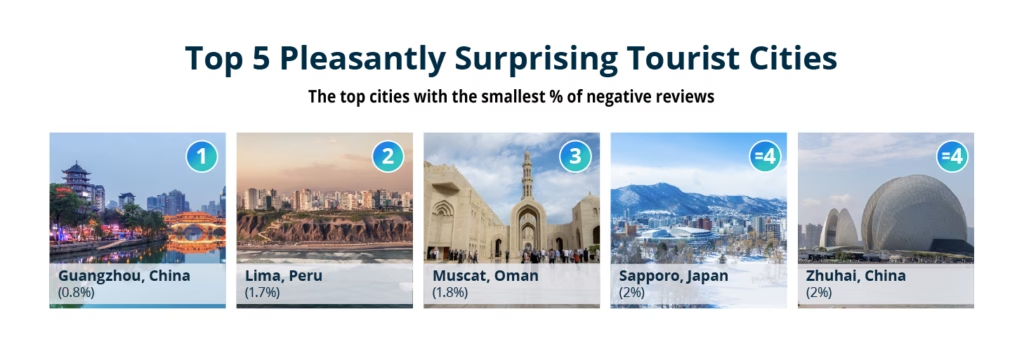Glamorous TikToks and wanderlust-filled travel blogs can set high expectations for tourist destinations. Sometimes they can set the wrong expectations.
When we visit a city and it simply does not live up to the image we have created in our head it can be upsetting. For some, this feeling can cause very real physical and mental pain and discomfort, called Paris syndrome.
We wanted to find out which cities were the worst culprits in the world for not living up to tourists’ expectations.
In our 2021 report, we discovered it was in fact the French capital itself which is most likely to disappoint visitors, however, when we updated the study in 2022, visitors to Orlando in the U.S. were revealed to be most likely to be left underwhelmed that year.
Ready for 2025, we ran the numbers again analyzing 97,409 visitor reviews, across 100 of the most visited cities in the world, to find out where the most lackluster holiday destinations are three years on (and which hidden gems outdo expectations).
Contents:
Key findings:
- Tourists in Cancún, Mexico are most likely to experience Paris syndrome as the city had the highest proportion of visitors (14.2%) disappointed with their visit
- Guangzhou, China, however, came out as the city where travellers are least likely to be disappointed (0.8% of reviews had negative mentions).
- Istanbul is considered the most ‘beautiful’ city while Dublin is the most ‘highly recommended’ according to tourist reviews.
- Toronto had the highest percentage of reviews where tourists felt ‘disappointed’.
- Paris without ‘Paris syndrome’: Despite being the study’s most disappointing city in 2021, in 2025 Paris had a lower proportion of negative reviews that the study average (1.8% compared to 4.2%)
What is Paris syndrome?
This very real psychological condition is sometimes experienced by first-time visitors to Paris, France, whose expectations of the city are so romanticized that they get overwhelmingly disappointed when they are faced with the reality. Interestingly, France travel statistics often show that Paris remains one of the most visited cities in the world, despite the mixed experiences some travelers report.

The quaint and fairytale-like image of Paris, portrayed in movies and books doesn’t always match the reality of this busy city, and the realization can sometimes leave tourists in a state of utter shock. In the French newspaper, Libération, the former President of the Franco-Japanese Medical Association was quoted stating that news and tourism media are primarily responsible for creating the syndrome’s less-than-realistic image of Paris. For many visitors, expectations also shift depending on Paris travel seasons, as the atmosphere of the city can feel completely different between summer crowds and quieter winter months.
Symptoms of Paris syndrome vary, but hallucinations, anxiety, dizziness, acute delusions and sweating are among the most commonly reported.
But in 2025 are you still most likely to experience “Paris Syndrome” (crushing disappointment) in Paris, and “Florence Syndrome” (being positively overwhelmed with emotion) in Florence?
2025 results of The Paris Syndrome Report
In 2021, our study found that Paris did in fact live up to the psychological condition’s name, as it was the most underwhelming city with the highest frequency of reviews, where expectations were not met, followed by Hong Kong. Travelers navigating the city can make their visit easier by using luggage lockers Paris to store bags while exploring, and similarly, visitors to Hong Kong often rely on baggage storage Hong Kong services to enjoy the city without being weighed down.
In 2022, we included 80 more cities and found that Orlando in the U.S. was revealed to be most likely to be left underwhelmed that year.
This year we collected 97,409 reviews from the ten most-reviewed tourist attractions in 100 cities around the world to rerun the results ready for 2025.
Cities where reality did not meet expectations

You can be left underwhelmed in every corner of the globe: as the top five most disappointing cities are spread across four continents. In 2022, the top five most disappointing locations were Orlando, Jakarta, Pattaya, Denpasar and Guilin. Three years on, the results are completely different.
Despite Cancún being one of the most popular beach destinations in Mexico – and actually planned and built for tourists – it has the highest percentage of negative reviews in the study (14.2%) including the greatest number of reviews including the word “disappoint”.
The city also has the highest frequency of reviews referencing “rip off” – so think before you buy when visiting.
Second to Cancún is Antalya, Turkey’s so-called “capital of tourism”, followed by another beach destination, Punta Cana in the Dominican Republic.
The top ten most underwhelming tourist cities can be seen below:
| Rank | City | Country | Negative comments in reviews |
| 1 | Cancún | Mexico | 14.2% |
| 2 | Antalya | Turkey | 12.2% |
| 3 | Punta Cana | Dominican Republic | 11.9% |
| 4 | Beijing | China | 11.2% |
| 5 | Orlando | United States | 10.6% |
| 6 | Mumbai | India | 10.0% |
| 7 | Honolulu | Hawaii | 9.9% |
| 8 | Johor Bahru | Malaysia | 9.4% |
| 9 | Kyoto | Japan | 9.1% |
| 10 | Playa Del Carmen | Mexico | 9.0% |
Cities that exceeded travelers’ expectations

But in better news, there were plenty of cities that exceeded expectations and impressed visitors. Considering the cities which have the smallest percentage of negative reviews, the study can reveal where to go to avoid disappointment.
Guangzhou, China, was the city that exceeded tourists’ expectations the most, with only 0.8% of the city’s reviews containing negative phrases.
The Peruvian capital city Lima was found to be the second least likely destination to disappoint tourists, followed by Muscat, Oman.
Below are the top ten cities that didn’t disappoint visitors, creating the true opposite of Paris syndrome:
| Rank | City | Country | Negative comments in reviews |
| 1 | Guangzhou | China | 0.8% |
| 2 | Lima | Peru | 1.7% |
| 3 | Muscat | Oman | 1.8% |
| =4 | Sapporo | Japan | 2.0% |
| =4 | Zhuhai | China | 2.0% |
| 6 | Vilnius | Lithuania | 2.2% |
| 7 | Santiago | Chile | 2.3% |
| 8 | Tallinn | Estonia | 2.3% |
| 9 | Shenzhen | China | 2.4% |
| =10 | Delhi | India | 2.5% |
| =10 | Mecca | Saudi Arabia | 2.5% |
| =10 | Guilin | China | 2.5% |
Words and phrases used to describe cities
We considered 19 negative words and phrases (as well as their inflections) to gauge how tourists felt about each city. But which cities stood out for specific experiences and phrases?
Under expectation
In 2022 Orlando accounted for 1 in 20 (4.6%) of all reviews globally in our analysis mentioning how ‘disappointed’ or ‘disappointing’ tourists found the experience, the most out of any city analyzed. Orlando also had the highest number of mentions for how ‘terrible’ tourists felt their experience was (7.4%), with Berlin behind that (3.8%).
In 2025, Toronto stood out as having the highest percentage of reviews that mention how ‘disappointed’ or ‘disappointing’ tourists found the experience (4.1%), followed by 2022’s most overrated destination Orlando (3.4%). Visitors often rely on baggage storage Toronto to move around freely while checking out the city’s restaurants, shops, and landmarks.
In 2025, the city most guilty of being simply ‘bad’ is Beijing, China holding 4.4% of reviews mentioning the word, followed closely by Orlando (3.7%) and Cancún (3.6%).
And when it comes to hospitality, Punta Cana had the most reviews citing ‘rude’ service (1.8%) followed by Antalya (1.7%) and Las Vegas (1.2%).
Over expectation
In 2022, the study found that Penang, Malaysia was where tourists were the most ‘pleasantly surprised’, with 2.3% of global mentions of the phrase being used to review Penang tourist attractions.
This year, when looking into positive words and phrases in the reviews, Dublin is the most ‘highly recommended’ city according to happy tourists (11.2% of reviews mention this phrase). The next most recommended cities were Edinburgh (10.9%) and Toronto (9.9%). Many visitors also appreciate practical services like Dublin luggage storage, which make exploring the city center without heavy bags far more enjoyable.
We found that Istanbul, Turkey was where tourists were the most ’beautiful’ city (33.9% of reviews mention this word), and Italy’s capital, Rome, took the top spot for having the most ‘must-see’ attractions (4.62%), as described by tourists. Travelers often note that using bag storage in Istanbul allows them to move freely through the bustling streets. Similarly, luggage lockers in Rome are praised for giving visitors more flexibility when exploring.
Scams and rip-off destinations
Our analysis also allowed us to see which destinations were angering tourists the most when it came to scams, poor value for money, and being ripped off.
In 2022, Orlando came top of the list, with the city holding onto 6.3% of the global reviews mentioning tourists being ripped off, followed by the Dominican Republic’s Punta Cana (3.9%). Singapore however had the highest percentage (8.2%) of reviews where tourists discussed how bad they felt the value of attractions on offer was.
In 2025, Cancún is top of the list, with the city holding onto 0.6% of the global reviews mentioning tourists being ripped off, followed by Antalya (0.3%). Lisbon however had the highest percentage (2.2%) of reviews where tourists discussed how the cost of entry to popular attractions was not worth the cost. Still, amenities such as Lisbon luggage lockers are often praised for adding ease to the travel experience.
Changes since the 2022 and 2021 index
In 2022 tourists in Orlando, U.S were the most likely to experience Paris syndrome as the city had the highest proportion of visitors complaining the city did not meet expectations.
Three years on, Orlando is still in the top three destinations with the greatest percentage of negative reviews. However, the two runners up in 2022 (Jakarta and Pattaya) have both considerably improved since then. Jakarta ranked 52nd in the study and Pattaya 66th.
A year before, in 2021, the study found that Paris did in fact live up to the psychological condition’s name, followed by Hong Kong.
Perhaps not such a dramatic improvement as Jakarta or Pattaya have seen, but Paris now ranks 33rd on the list of most disappointing destinations and Hong Kong 39th.
Methodology
We collected 97,409 Google reviews from the ten most-reviewed tourist attractions in 100 cities around the world based on international visitor numbers from EuroMonitor’s Top 100 City Destinations report and Mastercard’s ‘Global Cities Index’.
Russian cities and Kyiv were removed due to the full-scale Russian invasion of Ukraine, and Mecca was discounted due to the fact that it is inaccessible to non-muslim travellers. Other cities were discounted if they had less than 500 instances of positive and negative comments from tourists. Data was collected in October 2024.
To analyze which cities are most overrated versus most underrated, we looked at the occurrence of a set list of keywords to determine the words that are most frequently used to describe a destination. We then worked out a ratio of how often words associated with “overrated” versus “underrated” were being used to rank the destinations.
Making the Most of Your Trip to Paris
For visitors who want to make the most of their trip without the added stress of carrying heavy bags around the city, convenient luggage storage in Paris options are available to lighten the load and help you explore more comfortably.
Sources
- Google Maps, Various cities (https://www.google.com/maps)
- Euromonitor, ‘Top 100 City Destinations: 2019 Edition’ https://go.euromonitor.com/white-paper-travel-2019-100-cities.html
- Mastercard, ‘Global Destination Cities Index’ (https://newsroom.mastercard.com/wp-content/uploads/2016/09/FINAL-Global-Destination-Cities-Index-Report.pdf)
- Libération, ‘Des Japonais Entre Mal Du Pays Et Mal De Paris’ (https://web.archive.org/web/20191219211711/https://next.liberation.fr/vous/2004/12/13/des-japonais-entre-mal-du-pays-et-mal-de-paris_502663)
- The Atlantic, ‘Paris Syndrome: A First-Class Problem for a First-Class Vacation’ (https://www.theatlantic.com/health/archive/2011/10/paris-syndrome-a-first-class-problem-for-a-first-class-vacation/246743/)
- New York Times, ‘Florence’s Art Makes Some Go-to Pieces’ (https://www.nytimes.com/1989/05/15/world/florence-s-art-makes-some-go-to-pieces.html)
- The Telegraph, ‘Scientists investigate Stendhal Syndrome – fainting caused by great art’ (https://www.telegraph.co.uk/news/worldnews/europe/italy/7914746/Scientists-investigate-Stendhal-Syndrome-fainting-caused-by-great-art.html)

This work is licensed under a Creative Commons Attribution-ShareAlike 4.0 International License.

